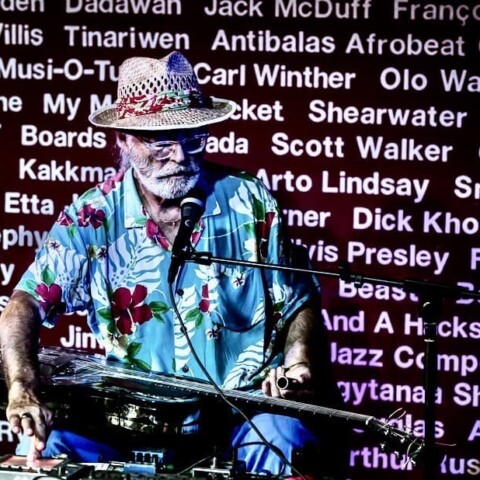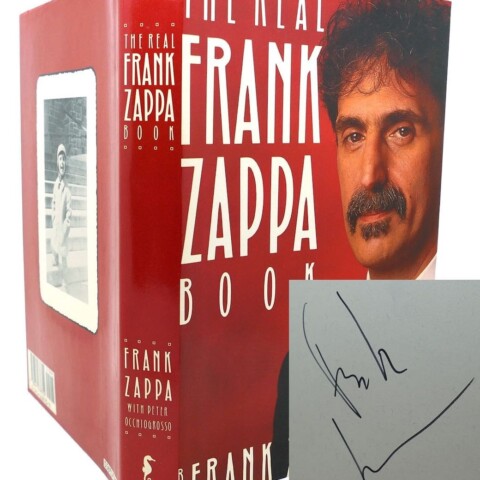With Universal issuing remastered versions of Frank Zappa’s enormous catalogue, Gary Steel takes up the challenge of reviewing every single one of FZ’s genius album creations. Today’s selection: Fillmore East June 1971.

FANS OF THE 1960s Zappa/Mothers were dismayed by Fillmore East, June 1971. As if they hadn’t already had to weather the stylistically improbable eclecticism of the first 11 albums; now, it seemed like Zappa had crossed the line, and really was churning out comedy music with little of the finesse of his most recent work, or the social commentary of the earlier Mothers albums.
For this release, recorded live and modeled on a bootleg – complete with scrawled, bootleg-style cover and serviceable, but less than hi-res recording quality – former Turtles singers Mark Volman and Howard Kaylan had been fully integrated into the grand scheme. In fact, it seemed like much of the material had been written specifically for the hairy duo, in order to fully utilise their unmistakable voices.
He used those voices to narrate and scream out an extended groupie routine that’s the centrepiece of the album, and which the majority of the songs are written around. Essentially, it’s a comedic socio-anthropological exploration of the relationship between groupies who won’t quite admit to being groupies and their rock star conquests, and it involves all manner of perverted goings-on (mostly the documented activities of Led Zeppelin and Vanilla Fudge), including after-hours sex games involving Seattle’s now-infamous Edgewater Inn, and the mudsharks and octopuses that could be fished from the water by lodgers with fishing lines dangling out their windows.
Many found these stories, recounted with much relish and enthusiasm by the band, to be intolerably brash and salacious, and the record certainly tested the censorship regulations of the time with its overt lyrics. (I won’t quote them here, but they are, of course, freely available on the internet, and fairly amusing they are, too).
Like parts of Absolutely Free, this is a kind of rock theatre, and its energy and overt nature certainly appealed to this reviewer’s adolescent self, although at the grand old age of 53 I have to admit that unlike most of Zappa’s albums, it lacks the musical depth to make listening to it now a pleasurable experience.
To me, there’s some kind of irony in the fact that Zappa got to use two of pop music’s best pop vocalists, but never used them for what they were really good at: harmonising. Well, I tell a small white lie. They do it once, sort of, on their satirical rendition of the Turtles’ biggest hit, ‘Happy Together’, which is used as a climax to the sexcapades in the “story”. But really, on this album I just find Volman and Kaylan to be too abrasive, too dominant, and because it’s a much slimmed-down group instrumentally, there’s less of note (and fewer notes) going on behind them. This, despite some amazing players.
Having said that, played on a system that doesn’t emphasise the somewhat hollow, texture-less sound, the album is a blast for at least three or four run-throughs, and it certainly has a lascivious rock’n’roll grit that Zappa’s more sophisticated, layered productions lack.
 Having used ‘Little House I Used To Live In’ as the opening theme, it then goes straight for the jugular with ‘The Mud Shark’, where, on a low-down funky vamp, they establish the venue and introduce “a succulent young lady with a taste for the bizarre.” In ‘What Kind Of Girl Do You Think We Are?’, Volman and Kaylan play the part of rock star and groupie, respectively, and of course, he’s attempting to ‘get into her pants’. And so it goes… ‘Bwana Dik’ is lurid, horny, and contains some brilliant wordplay, if you’re willing to forgive its transgressions against good taste, and then ‘Latex Solar Beef’ goes for a raw blues groove.
Having used ‘Little House I Used To Live In’ as the opening theme, it then goes straight for the jugular with ‘The Mud Shark’, where, on a low-down funky vamp, they establish the venue and introduce “a succulent young lady with a taste for the bizarre.” In ‘What Kind Of Girl Do You Think We Are?’, Volman and Kaylan play the part of rock star and groupie, respectively, and of course, he’s attempting to ‘get into her pants’. And so it goes… ‘Bwana Dik’ is lurid, horny, and contains some brilliant wordplay, if you’re willing to forgive its transgressions against good taste, and then ‘Latex Solar Beef’ goes for a raw blues groove.
The first side on vinyl finished with ‘Willie The Pimp Part 1’, a four-minute guitar blow-out that continued as ‘Willie The Pimp Part 2’ at the beginning of side 2. When the CD was first issued, Zappa deleted the second part, claiming that it sounded wrong coming straight after the first part on CD, because they were both from different performances. They’ve fixed that poor decision here and reinstated the second part, which is a short, brilliant blast of hard rock wah-wah guitar.
‘Do You Like My New Car?’ is the conclusion to the album’s “story”, and sees the rock star getting frustrated and angry with the teasing fan/groupie. This piece contains the most offensive words, for those who offend easily, although it’s pretty funny. I’ve always loved the fantasy reference to “three unreleased recordings of Crosby Stills Nash & Young fighting in the dressing rooms at the Fillmore East.” If Zappa was only good for one thing (and we know that’s not true) he was certainly a valuable shit-detector in regards to the preposterous behaviour and activities of popular music heroes of the era.
To get his piece of pie, the musician relents and plays his big hit, ‘Happy Together’, and it’s a pretty good version. Then it’s the encore, and musically, the highlight of the album. First, Don Preston gets let loose on his Mini-Moog on ‘Lonesome Electric Turkey’, then a very pleasant version of Hot Rats classic ‘Peaches En Ragalia’ is performed, and lastly, there’s ‘Tears Began To Fall’. I don’t know where this piece came from, how Zappa conjured it up, or when it was written, but it’s a classic slice of pure old-fashioned pop that could, in the right time and right place, have been a smash hit. I’m sure that putting the smash pop hit that never would be a smash pop hit at the end of a record about the adulation of famous rock stars was intentional on Zappa’s part, because in its own way, it’s every bit as good a song as ‘Happy Together’.
 The very next year, John Lennon released his live album, Some Time In New York City, part of which was recorded at the same Zappa show, where Lennon and Yoko Ono were guests. Sadly, on that album, Zappa compositions go uncredited, but we do get to hear a brilliant Zappa guitar solo in amongst Ono’s unique vocal stylings. The year before he died, Zappa finally got his own back on Lennon (who was well-dead by then, of course) with Playground Psychotics, a full double album of the entire concert, including his mix of Lennon and Ono’s guest performance. It included the piece, possibly named after the event, called ‘A Small Eternity With Yoko Ono.’
The very next year, John Lennon released his live album, Some Time In New York City, part of which was recorded at the same Zappa show, where Lennon and Yoko Ono were guests. Sadly, on that album, Zappa compositions go uncredited, but we do get to hear a brilliant Zappa guitar solo in amongst Ono’s unique vocal stylings. The year before he died, Zappa finally got his own back on Lennon (who was well-dead by then, of course) with Playground Psychotics, a full double album of the entire concert, including his mix of Lennon and Ono’s guest performance. It included the piece, possibly named after the event, called ‘A Small Eternity With Yoko Ono.’
While I can’t muster a huge amount of enthusiasm for Fillmore East, June 1971, and it undoubtedly contributed to the scorn that some have heaped on Zappa over the years, and his polarisation of audiences, I still think it has immense value in socio-anthropological terms. No one else was cataloguing or commenting on rock star behaviour, or the way of life of that particular segment of society, back when it was still a nascent form. Someone had to do it, and one day, when rock is well dead, an album like this will pique the interest of the curious all over again.
The new version is essential for completists, if only for its reinstatement of ‘Willie The Pimp Part 2’. While the sound is just average, there’s certainly more ‘oomph’ in this new version, which uses the original 1971 analogue master, and is remastered by Doug Sax. GARY STEEL
ZAPPA UNIVERSE RATING –
Music: 3/5
Sound: 3/5














